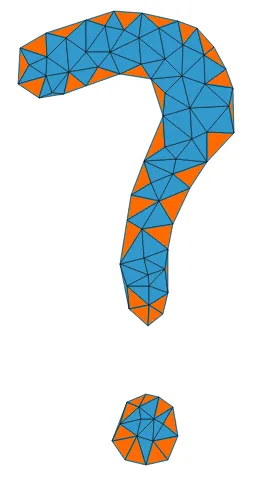对于三维点情况(四面体),Hanniel的答案 进行了轻微修改。
from scipy.spatial import Delaunay
import numpy as np
import math
def alpha_shape(points, alpha, only_outer=True):
"""
Compute the alpha shape (concave hull) of a set of points.
:param points: np.array of shape (n, 3) points.
:param alpha: alpha value.
:param only_outer: boolean value to specify if we keep only the outer border
or also inner edges.
:return: set of (i,j) pairs representing edges of the alpha-shape. (i,j) are
the indices in the points array.
"""
assert points.shape[0] > 3, "Need at least four points"
def add_edge(edges, i, j):
"""
Add a line between the i-th and j-th points,
if not in the set already
"""
if (i, j) in edges or (j, i) in edges:
if only_outer:
if (j, i) in edges:
edges.remove((j, i))
return
edges.add((i, j))
tri = Delaunay(points)
edges = set()
print(tri.vertices.shape)
for ia, ib, ic, id in tri.vertices:
pa = points[ia]
pb = points[ib]
pc = points[ic]
pd = points[id]
pa2 = np.dot(pa, pa)
pb2 = np.dot(pb, pb)
pc2 = np.dot(pc, pc)
pd2 = np.dot(pd, pd)
a = np.linalg.det(np.array([np.append(pa, 1), np.append(pb, 1), np.append(pc, 1), np.append(pd, 1)]))
Dx = np.linalg.det(np.array([np.array([pa2, pa[1], pa[2], 1]),
np.array([pb2, pb[1], pb[2], 1]),
np.array([pc2, pc[1], pc[2], 1]),
np.array([pd2, pd[1], pd[2], 1])]))
Dy = - np.linalg.det(np.array([np.array([pa2, pa[0], pa[2], 1]),
np.array([pb2, pb[0], pb[2], 1]),
np.array([pc2, pc[0], pc[2], 1]),
np.array([pd2, pd[0], pd[2], 1])]))
Dz = np.linalg.det(np.array([np.array([pa2, pa[0], pa[1], 1]),
np.array([pb2, pb[0], pb[1], 1]),
np.array([pc2, pc[0], pc[1], 1]),
np.array([pd2, pd[0], pd[1], 1])]))
c = np.linalg.det(np.array([np.array([pa2, pa[0], pa[1], pa[2]]),
np.array([pb2, pb[0], pb[1], pb[2]]),
np.array([pc2, pc[0], pc[1], pc[2]]),
np.array([pd2, pd[0], pd[1], pd[2]])]))
circum_r = math.sqrt(math.pow(Dx, 2) + math.pow(Dy, 2) + math.pow(Dz, 2) - 4 * a * c) / (2 * abs(a))
if circum_r < alpha:
add_edge(edges, ia, ib)
add_edge(edges, ib, ic)
add_edge(edges, ic, id)
add_edge(edges, id, ia)
add_edge(edges, ia, ic)
add_edge(edges, ib, id)
return edges
